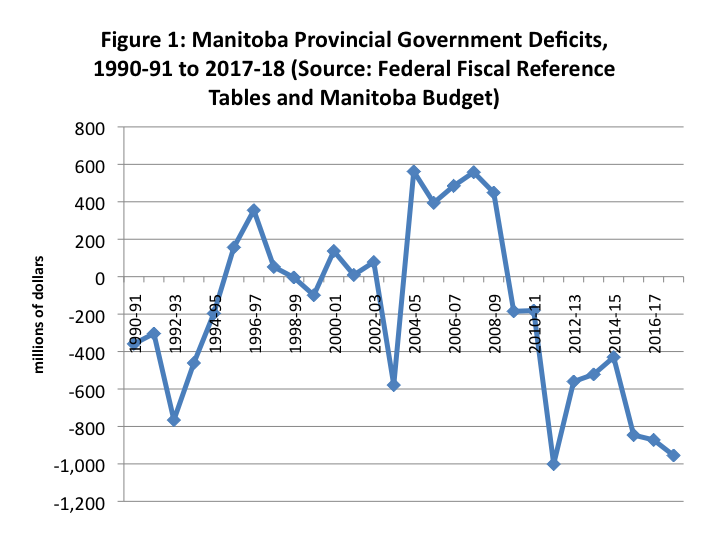The Forgotten Middle: Public Debt in Manitoba
Most public policy discussions of provincial government deficits and debt in Canada have tended to focus on the bigger provinces: namely Ontario, Quebec, Alberta and British Columbia. Manitoba often flies under the radar especially given that its diversified economy has been quite stable, shown good growth rates and generated unemployment rates at or below the national average. Yet, Manitoba has not balanced a budget since 2009 and has seen its provincial net debt grow alarmingly high.
In 2008-09, Manitoba’s provincial government had revenues of $12.611 billion and expenditures of $12.162 for a surplus of $449 million dollars. Since then, annual deficits ranged from lows of $185 and $181 million in 2009-10 and 2010-11 to highs of $1.001 billion in 2011-12 and a forecast $955 million in 2017-18. All together, these deficits total $5.552 billion. This is the longest string of consecutive deficits – nine in total -- since the early 1990s which saw a string of five.

The result has been a steadily mounting provincial government debt and a rising debt to GDP ratio. In 1990-91, the provincial government net debt was $4.773 billion and it is expected to reach $24.722 billion in 2017-18. As a share of GDP, net debt was approximately 19 percent in 1990-91 and is expected to reach almost 36 percent in 2017-18. The recent growth in debt has reversed nearly a decade of progress that saw the net debt to GDP ratio fall from 32 percent in 1997-98 to 21 percent by 2007-08.
Higher debt comes at a price – higher interest costs. While Manitoba like other debt-laden jurisdictions has benefitted from low interest rates, more debt has still meant more debt service costs. For 2017-18, debt charges are expected to be $991 million –the most Manitoba has ever paid to service its debt since 1990. Debt service represents just over 6 percent of total provincial government revenues.
What’s the opportunity cost? That amount is equivalent to about 15 percent of Manitoba’s public health spending or nearly a quarter of its education spending.
Manitoba faces some challenging times. It is seeing a rising net debt and rising interest costs at a time when its provincial economy has been doing relatively well. For 2016, the Manitoba Bureau of Statistics estimated that Manitoba’s real GDP grew 1.9 percent – above the national average and forecasts growth of 2.2 percent for 2017 – fourth highest among Canada’s provinces. Despite such relatively robust growth, Manitoba is still running large deficits and those deficits might be even larger if not for the fact that the federal government provides it with billions of dollars a year in transfer payments - $4.163 billion expected in 2017-18 or about 26 percent of provincial government revenues.
Manitoba has some very pressing fiscal issues to address given that it is accumulating debt at a rapid clip, despite a well performing economy and reliance on federal transfers for one quarter of its provincial government revenue. Tucked away in the middle of the country, Manitoba has managed to keep a relatively low profile when it comes to its fiscal situation.
Author:
Subscribe to the Fraser Institute
Get the latest news from the Fraser Institute on the latest research studies, news and events.

